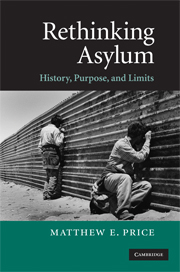Book contents
- Frontmatter
- Contents
- Acknowledgments
- Introduction
- Chapter 1 Recovering Asylum's Political Roots
- Chapter 2 Promoting Political Values through Asylum
- Chapter 3 What is “Persecution”?
- Chapter 4 Persecution by Private Parties
- Chapter 5 Asylum, Temporary Protection, and the Refugee Policy Toolkit
- Chapter 6 Restrictions on Access to Asylum
- Conclusion
- Bibliography
- Index
Chapter 5 - Asylum, Temporary Protection, and the Refugee Policy Toolkit
Published online by Cambridge University Press: 26 January 2010
- Frontmatter
- Contents
- Acknowledgments
- Introduction
- Chapter 1 Recovering Asylum's Political Roots
- Chapter 2 Promoting Political Values through Asylum
- Chapter 3 What is “Persecution”?
- Chapter 4 Persecution by Private Parties
- Chapter 5 Asylum, Temporary Protection, and the Refugee Policy Toolkit
- Chapter 6 Restrictions on Access to Asylum
- Conclusion
- Bibliography
- Index
Summary
I have so far argued that asylum is a distinctive mode of refugee relief because it is expressive rather than merely palliative. That sets it apart from other refugee policy tools, such as humanitarian protection and in situ relief aid. This chapter further explores asylum's place in the refugee policy toolkit. In particular, I address two questions.
First, what is the nature of the remedy that asylum offers to persecuted people? Should they be entitled to remain indefinitely in the state of refuge? Should they be eligible to become citizens? Or should asylum instead be granted for a presumptively temporary period? I argue that persecuted people should receive membership in the state of refuge, and that the necessity of that remedy further distinguishes asylum from other refugee policy tools. I also explore the proper scope of humanitarian protection available to non-persecuted refugees.
Second, how should states, which have limited resources to devote to refugee policy, allocate them among various refugee policy tools? If the ultimate goal of refugee policy is to save the most lives possible, one might question whether resources expended on asylum are well spent. First, asylum has a “proximity bias”: it is available only to refugees who manage to enter the territory of the state of refuge. But those refugees might not be the most in need of help.
- Type
- Chapter
- Information
- Rethinking AsylumHistory, Purpose, and Limits, pp. 164 - 199Publisher: Cambridge University PressPrint publication year: 2009



